My Winter 2015-2016 Sports Gadget Recommendations
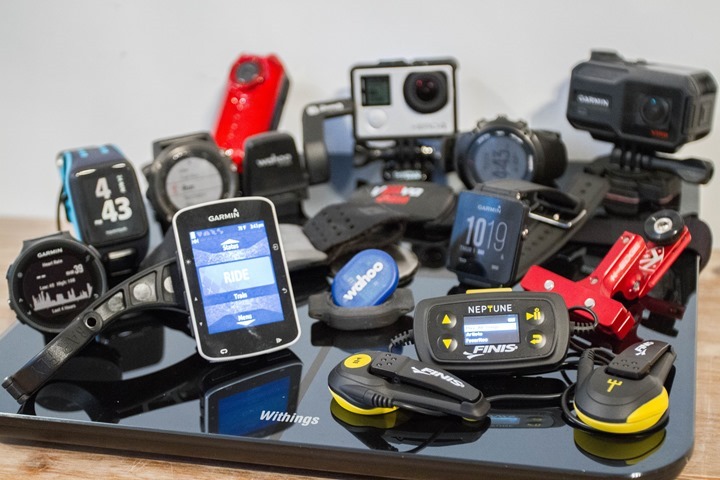
Introduction:
(Before we start, you can find my Black Friday deals post here, expect a massive update of products on sale on Thursday morning when many deals kick off. This guide attempts to as best as possible take into account those price changes, while also providing guidance beyond this weekend.)
It’s once again that time of year for my recommendations guide. I tend to time this to be just ahead of the holiday buying season, but more importantly to take into account what is usually a glut of new devices that have arrived over the past 45-60 days. I’ve been holding off just a few weeks longer than I’d normally want to, simply to ensure adequate time with all of these devices before making recommendations. That said, there are a couple of ‘provisional recommendations’ based on devices that have just arrived in the last few days or weeks where I don’t feel like I quite have the time I want to make a solid recommendation. Yet, ignoring them would be equally wonky.
My goal here being to give my specific recommendations – exactly the same recommendations I’d give to my own friends and family. This post isn’t here to list every option on the market in an effort to make every manufacturer happy. Nope, it’s a clear cut ‘what I’d buy’ for certain use cases. Of course as more and more companies get into the market, there ends up being more and more possible scenarios as the products expand in functionality.
If you’re looking for a listing of what I use day to day, check out my ‘Gear I Use’ list, as well as The Girl’s list too (about the only thing that might change on my list is using the FR235 instead of the FR620 for running, we’ll see…).
Finally, if you use either the Amazon or Clever Training links, you help support the site. I’ve partnered with Clever Training to offer all DC Rainmaker readers exclusive benefits on all products purchased. You can read more about the benefits of this partnership here. You can pickup most devices below through Clever Training using the links in the tables. By doing so, you not only support the site (and all the work I do here) – but you also get to enjoy the significant partnership benefits that are just for DC Rainmaker readers (like saving 10% on non-clearance/deep-sale items). And, if you are picking up items that are more than $75, you can get free US shipping as well.
With that, let’s dive into it!
Running GPS Watches:
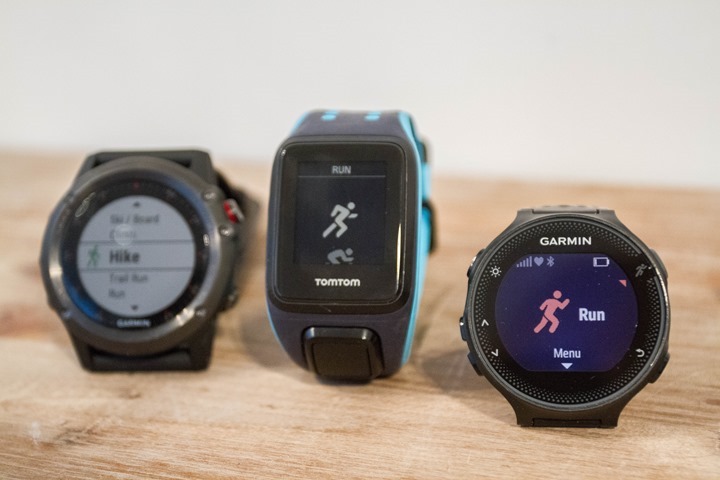
Note that I’ve re-split up these recommendations this year a bit. Also note that in this case I’m specifically referring to running watches, not multisport watches, they have their own category. For this category I assume that you’re going to spend 80%+ of your time running.
Do keep in mind that this category is semi-heavy Garmin, because quite frankly – neither Polar or Suunto have released new running-specific watches this year (just variants of existing products). Or even last year either in the case of Polar. The only other mainstream entrant that deserved to be here was TomTom, which you’ll find below.
Road Running – Best All Arounder: Garmin FR230/235
I think Garmin really nailed it with the FR230/235 series. The singular difference between these watches is the optical sensor in the FR235, which the FR230 lacks. This unit replaces the FR220/225 products of the past, which I felt were overpriced in the mid-range arena compared to Polar’s M400. But with the FR230, Garmin added in a slew of features once previously only seen on the $400 watches, now at $250.
The FR235 meanwhile has optical HR in it. In my testing it’s good. Not perfect yet, but generally very strong for running (less so cycling). I think the gaps that I have seen with it, they’ll be able to solve – such as more smoothing needed, as well as an already planned upcoming battery improvement fix. You’ll see my full in-depth review of it sometime late Wednesday (today).
I suspect that the FR235 will become my primary running watch. Whether or not I end up using the optical sensor on it 100% of the time might be up for debate still, but it checks all the boxes I care about in a running watch today.
Road Running – Geekful of data: Garmin FR630
This is a bit of a new category. Previously I’ve done it more by price breakouts, but I think that with the slight change in product lineups by comparing geeky data features it deserves its own category.
Right now, there’s no watch that gives as much geeky running data as the FR630. Sure, the Fenix3 and FR920XT are soon getting the Gen2 Running Dynamics, but the FR630 does contain things like the Lactate Threshold testing and music/playlist control from your phone. More than that though, it’s just a heck of a lot smaller.
To be clear, you can get about 95% of the stuff in the FR630 on a Fenix3/FR920XT, but it’s really the size as the reason people go smaller. Some won’t care about that – but for others that’s hugely important.
(Note: This recommendation is semi-provisional right now, since my in-depth review is still pending, likely publishing early next week. Right now things are mostly quite good, though there are a few hiccups on the touch screen I’m still working through.)
Running – With Music: TomTom Spark
Ok, at the expense of creating a category for the sake of creating a category – too many people asked about this in years past. So let’s keep this simple: If you want music with your running GPS watch, go out and get the TomTom Spark. You can get it with or without optical heart rate. You could also look at the Adidas Smart Run GPS, but I find that awkwardly big for most people, and it tends to be a bit pricier.
The TomTom Spark includes 3GB of music storage, and you can use any Bluetooth headphones to connect to it. Otherwise, it’s a pretty clean and straightforward mid-range GPS running watch.
Running – Best Sub-$200 Watch: TomTom Runner2 Variants
Now this one is tricky. Yes, there’s the Garmin FR25 that’s out there – and it’s a great little watch that has smart notifications. It sits in there around $169. But, at the same time, there’s the TomTom Runner & Spark/Runner2 units. The base TomTom Spark/Runner2 is at $149, which makes it far more functional than the FR25, minus the text notifications (but that’s coming soon anyway). It just has more features. Though the FR25 is smaller on the wrist. Of course, the Polar M400 is often in the same price range too – though it seems to have long term issues with the USB connector. Still, it’s a good running watch and thus something you can consider and compare features.
Yet it gets even messier. See, the original TomTom Runner also often goes on sale for sub-$99 (it’s currently $99), making it even better than the FR10/15 below. So you’ve gotta be a little bit aware of things there. If you see the original TomTom units sub-$100, go for them over the Garmin’s. Otherwise, for that $100-$199 range, hit up the TomTom Runner2/Spark.
Running – Best Sub-$100 Watch: FR10/15 on big sale, TomTom Runner otherwise
Finally, heed the advice in the previous paragraph first, and then assuming none of them are sub-$100, then dig around for the FR10/FR15 on sale. I’ve seen it for as low as $50, off and on lately on random sales. Otherwise, the TomTom Runner is $99 most of the time and a sweet deal.
Sure, there are other cheap watches in that ballpark (usually more $60-$80), but overwhelmingly the complaints I hear from folks is that the software on those platforms is flaky at best, and cumbersome at worst. In my occasional testing of units out there (I buy a lot of random stuff to try out), I find the user interfaces super-old school and support rough. It’s usually just worth an extra Starbucks Frappuccino or two to get a unit from Garmin or TomTom here.
Hiking/Trail/Ultra Running – Best in Class: Fenix3, or Ambit 3 on sale.
My advice here is nearly the same as last year – if you’re spending time out in the woods, get the Fenix3. It’s simply the best all around option for people spending time out in the trails. It has everything the FR920XT does, except more navigation related features. Oh, and it looks a heck of a lot more classy. So for some of you, you’ll get it just because it’s classy looking. Note that you can easily swap any of my recommendations above on running (or triathlon below) for the Fenix3 if you’d like. It’s simply that I believe the Fenix3 is overkill for most runners, albeit just as easy to use as the other watches.
However, you’ll note the Ambit3 is in there. Some believe the Ambit3 has better GPS accuracy in harder conditions than the Fenix3. I think that may be barely true, but only to a certain point. I did some hiking this summer and found that in the hardest of conditions, all three companies (Garmin/Polar/Suunto) can get into trouble just as much as each other. However, if you can find a good deal on the Ambit3, then it’s still a superb product. Just one that lacks all of the features of the Fenix3 lineup. Simply decide if you need those features.
The one caveat would be if you really really really want mapping, then Epix is honestly your only choice. It has all the features of the Fenix3, but also with visual maps you can load and buy. But in general it just doesn’t make my general recommendations guide. I think it’s usually a good device, but just not my cup of tea.
Copyright DC Rainmaker – Updated May 26th, 2016 @ 7:55 pm
TomTom Spark$149-$199 (Features Vary)LinkLinkLink
Garmin Forerunner 230$249LinkLinkLink
Garmin Forerunner 235$329LinkLinkLink
Garmin Forerunner 630$399LinkLinkLink
Garmin Fenix3$499LinkLinkLink
Garmin Epix$549LinkLinkLink
Suunto Ambit3 Peak$499LinkLinkLink
Garmin Forerunner 15$139LinkLinkLink
TomTom Runner$99LinkLinkLink
Garmin Forerunner 10$129LinkLinkLink
Triathlon GPS Watches:
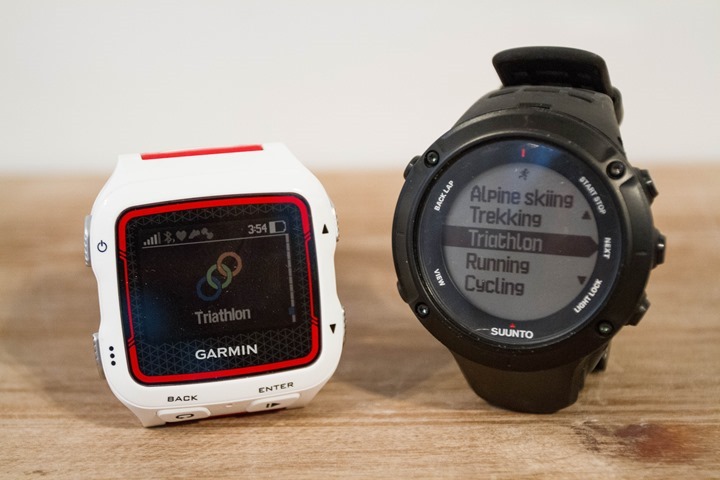
This category is for what the industry calls ‘multisport’ watches, but that typically just translates to triathlon watches. They track your time/distance/etc… within the three sports – swim/bike/run. From a non-triathlon multisport aspect, these watches are often used by everyone from wind surfers to skaters, mostly because of their versatility and flexibility in configuration and display customization.
Overall Best in Class: Garmin FR920XT and Fenix3
I’m not really sure there’s any surprise here. Garmin dominates this category for good reason – it’s simply got the most features for the buck – and it’s got more flexibility than other watches. They’re the only units that offer a quick release for moving from swim to bike to run, as well as offering far superior power meter capabilities than either Suunto or Polar.
As for choosing between the two, it’s honestly mostly going to come down to style choice and display preferences. The Fenix3 is more fashionable in an office setting, whereas the FR920XT tends to be more sporty in a Newton shoes sense. The Fenix3 also offers more navigational features, in the event you’re doing hiking and the like.
Note that the Epix does actually have all the software features of the FR920XT & Fenix3 from a triathlon standpoint, and of course includes maps too, but it’s bigger and costs more. And for 99.99% of people out there, it’s probably unnecessary for triathlon.
Budget Options: Suunto Ambits on Sale
Now if you’re looking for a budget watch, the Suunto Ambit’s when on sale tend to be great alternatives. Both Peak and Sport models are strong contenders in triathlon realm, though they lack really strong power meter support – so if you have a power meter, you might want to look elsewhere. But if you’re getting into the sport, there can be some great deals here. Note that the Ambit3 Run does NOT include swimming or cycling sensor support – so you’ll want to avoid that. But the Ambit3 Peak and Sport both include it, and I often use the Ambit3 as a solid reference unit in openwater swim tests (I find it consistently tends to perform the best there out of all openwater swim units I use).
As for deciding between Peak and Sport, the key difference is the barometric altimeter. I find that Suunto has done a superb job with GPS based elevation, so I think the Peak is less valuable for triathletes (but more valuable if you’re out on a trail/hike).
Note: For triathlon I do NOT recommend the TomTom Cardio/Spark or Vivoactive:
I want to be really clear on this. The reason I don’t recommend these watches is twofold, but mainly centers on the fact that they don’t support a multisport mode. Yes, it supports running, and cycling, and indoor swimming. But you can’t tie all those together in a race or training. Further, it doesn’t support openwater swimming.
This is pretty similar for some of the other running watches like the Polar M400 or Garmin FR230/235/620/630. Yes, they all support running and cycling, but none support swimming metrics and none support multisport modes. If you cycle sparingly and don’t swim, then they’re all still viable options.
Copyright DC Rainmaker – Updated May 26th, 2016 @ 7:55 pm
Garmin Fenix3$499LinkLinkLink
Garmin Forerunner 920XT$449LinkLinkLink
Suunto Ambit3 Sport$399LinkLinkLink
Suunto Ambit3 Peak$499LinkLinkLink
Suunto Ambit2 R$250LinkLinkLink
Suunto Ambit2$319LinkLinkLink
Suunto Ambit2 S$219LinkLinkLink
Cycling GPS Units:
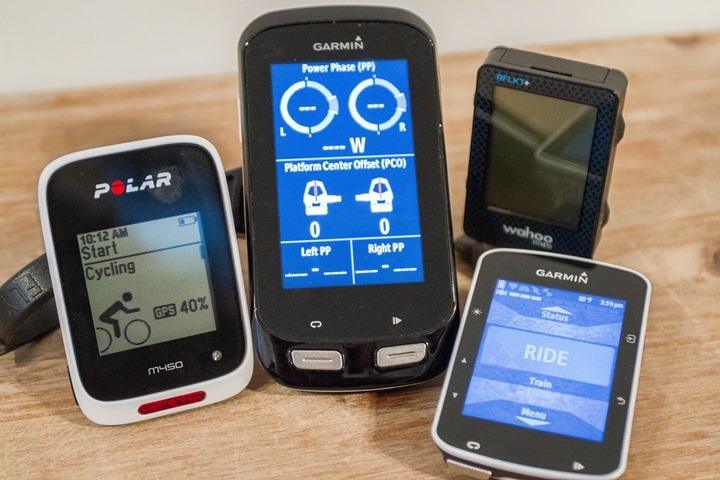
This field has mostly seen competitors abandon it. No, really, they have. Sure PowerTap has released a slightly updated version of the Joule GPS+ with Bluetooth capabilities, and Mio has pretty much stopped updating their cycling series with anything meaningful. Cateye has made some inroads in the lower-end market, but that’s it.
Really the only one who’s given it a go is Polar, for which they submitted a rock star entry this past summer in the M450. We of course also have Wahoo with their pending ELEMNT, which looks like it could be a very solid first go at the GPS bike computers, however, it just got delayed till January – so it can’t make the cut for now, but is certainly something to keep tabs on.
Best All Around Cycling GPS: Garmin Edge 520:
Over the last few months, I’ve totally transitioned my bike computers to being a fleet of Edge 520’s. Of course, I use multiple head units for recording data, and these days I’ve literally got four of them up on my handlebars for day to day rides recording power meter data.
For everyone else though – it’s my best overall recommendation on a bike computer. It’s got built-in Strava segment support, while also having the ability to add maps to it for basic navigation/awareness. Plus upcoming Connect IQ support for 3rd party apps. And, it’s just about the right size and really nails the experience. This hands-down wins this category.
Best Budget GPS Unit: Polar M450
Now, at half the price of the Edge 520 is the Polar M450. It was announced about two weeks prior to the Edge 520, and is a sweet little unit for $169. It’s essentially the core features you want on a GPS bike computer, in a rather nice little size. It can sync your rides afterwards via Bluetooth Smart, and soon also send those completed rides to Strava wirelessly (a major step forward for Polar). Basically, if you don’t have a power meter, don’t care about on-unit mapping, and don’t care about Strava Segment integration, then I’d definitely consider this unit – especially if you have Bluetooth Smart sensors.
Best Commuter Options: Wahoo RFLKT
Now this is a super-interesting option right now, in light of Wahoo’s Black Friday sale that will put the base RFLKT at $49. Even more so since last week they announced smartphone notifications will now appear on the RFLKT, plus a bunch of other backend changes they’ve made in recent firmware, based on Wahoo ELEMNT learning’s. For $49 you get something that you can easily pop on a commuter bike and ride with to record stats and quickly upload them to various sites. Plus, you can connect to Bluetooth Smart sensors too (if you get the RFLKT+ version, you can also connect to ANT+ sensors).
I think if post-Black Friday they keep the price in the $69-$79 range, sorta like the Bontrager Node units used to be, it’d be a fascinatingly compelling price point/product.
Copyright DC Rainmaker – Updated May 26th, 2016 @ 7:55 pm
Garmin Edge 520$299LinkLinkLink
Polar M450$169LinkLinkLink
Wahoo Fitness RFLKT+$130LinkLinkLink
Swimming:
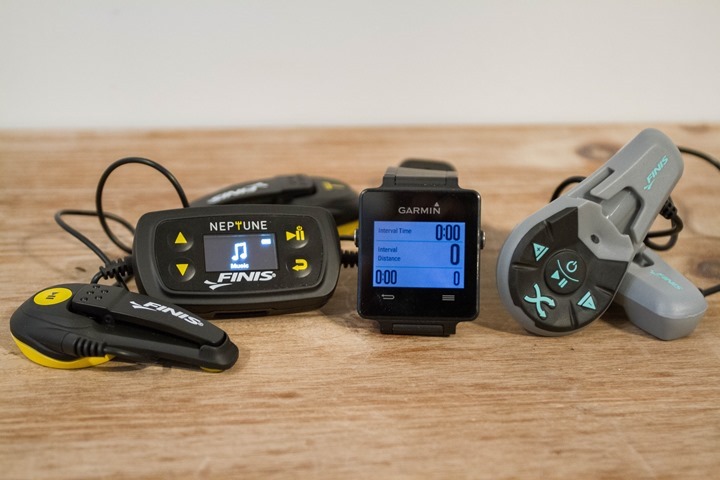
Swimming devices continue to be a funny realm that mostly gets ignored by companies, since many competitive swimmers don’t like to wear tech (or even a basic watch). So it’s hard to make inroads into the category with such a small market. Still, here’s some thoughts.
MP3 Players: FINIS Neptune*
This has been my mainstay recommendation for a swimming MP3 player for about two years now, mostly because I like the display aspect, since it makes it easy to get things queued up, while the sound quality is also just fine for a pool. And then finally, the buttons also makes it easy. If I look at reader feedback, most are quite happy as well there – with the only complaints coming from folks that require swappage of the device after significant use (which FINIS covers).
*You’ll notice an asterisk, that’s because FINIS just last week started shipping their new Duo (pictured above). This sorta combines the Neptune functionality with that of the original SwiMP3, it also fixes much of the charging issues with the SwiMP3. I just haven’t had time to really dig into it yet, but it’s something to keep an eye on.
Indoor Pool Watch: “It’s Complicated”…with a side of Vivoactive.
This one is also messy, because I’ve previously recommended (and loved) the Garmin Swim watch. It was roughly sub-$150, but also now like 3-4 years old and basically untouched. From a functionality standpoint it was great having a year-long battery life so it just hung out in your swim bag and sync’d when it was close to your computer. However, it lacked Bluetooth Smart for your phone to download that way, so it’s kinda lost favored nation status.
Instead, your next best bet is the Vivoactive, which is sub-$200 these days. It’s slimmer than the Garmin Swim was, and just as capable in the pool. Plus, it has running and cycling and activity tracking and all sorts of other jazz. Still, I wish there was a Garmin Swim2 with Bluetooth…and done.
Openwater Swim: No good answer
Quite frankly, nobody makes a good dedicated outdoor swim watch. Your best bet here is to either get one of the multisport/triathlon watches for openwater swim mode (on your wrist). Or, to otherwise just use any GPS you have and plop it in your swimcap using the swimcap method.
Sensors and mounts:
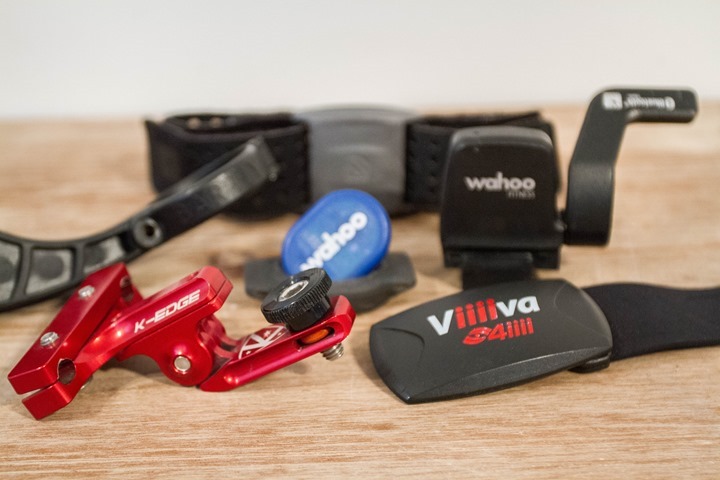
If you’re getting any of the units listed above, you may be in the market for accessories. Obviously, some bundles include accessories, while others do not. Here’s what I recommend based on having entire buckets worth of accessories to test with.
Before I get started, I’ll note that when possible I’d highly recommend folks buy dual ANT+ & Bluetooth Smart (BLE) sensors. These are available in almost all categories now. The reason for going dual is simple: It allows you the flexibility to choose whichever device you want and know it’ll work with it.
Heart Rate Sensor: Scosche Rhythm+ (Optical Sensor)
This is my primary and singular running/cycling/hiking/etc heart rate sensor (when not testing something else). I just love it. While I liked the Mio Link wrist straps, I’ve found the signal too weak in some cases and then also not quite as stable as the Scosche from a measurement standpoint. The Scosche is dual ANT+/Bluetooth Smart, so it can transmit to just about anything. I’ve used it now as my primary strap for almost two years. You’ll see it in almost all my tests these days.
Speed/Cadence: Wahoo BlueSCv2
Wahoo’s BlueSCv2 is what I use when I want a combo speed/cadence sensor, which includes both ANT+ & Bluetooth Smart (dual) Thus, two for the price of one. I love this model though because of the quick release bands making it easy to move between bikes if you need to. You’ll find this on all my bikes where I’m doing power meter testing, as I use the magnets as a ‘known good’ for validating cadence readings.
If however, you’re looking for a cheaper (ANT+ only) combo option, just simply pickup the Garmin GSC-10 – which usually hovers around $30-$35. I believe Bontrager also has a dual option out these days too, but I haven’t tried it yet.
Cadence-Only: Wahoo RPMv2
This one is another unit that you’ll find on many of my test bikes, mostly because of portability. I also take it with me travelling when I’m using a hotel spin bike. It’s a small pod that attaches to the side of your bike crank and it transmits on both ANT+ and Bluetooth Smart, so you can use it with your Garmin device or your smart phone.
Speed-Only: Garmin Speed-Only Sensor
Since Wahoo hasn’t yet come out with a dual ANT+/BLE speed sensor, it’s the Garmin one for the win. This little sensor is perfect if you only want speed. It requires no magnets and no zipties, and just simply clips on your back (or front) wheel. I wrote up a thing on it here previously.
Note: You can also try out the Velocomp dual ANT+/BLE sensors, which I’ve been using on and off – but I just haven’t tried the BLE portion out as much yet.
Running Footpods (ANT+): The Timex, Suunto, and Garmin mini-footpods (whatever is cheapest that day)
As long as you pickup any of those three above they all work the exact same way and all function with any ANT+ device. In other words, just pickup whatever is cheapest that day. Ensure that you aren’t picking up the giganto footpods of yesteryear.
If/when in doubt, check out my post on ‘All you ever wanted to know about the ANT+ footpod’.
Running Footpods (Bluetooth Smart) : Adidas miCoach Bluetooth Smart Footpod
For Bluetooth Smart footpod capable devices or apps, I’d go with the Adidas one. It’s the smallest BLE footpod on the market and works great with most devices.
Best ANT+ to BLE Bridging Solution: 4iiii Viiiiva
While this may seem an odd category, I keep getting requests for it – so I’m putting it here to assist folks in my recommendation. There is really only one other competitor in this space, which is the Mio Velo. However, I find that 4iiii has done a much better job with the overall ‘package’ on the Viiiiva, which just got a huge pile of cool updates even this week (years after release), including the ability to save data while away from the phone and the ability to work with ANT+ gym equipment (something Garmin watches used to do). Oh, and it’s still a dual ANT+/BLE HR strap.
Bike Computer Mounts (just computer): Barfly Mounts
I love my Barfly, specifically for triathlon, the TT/Aero Barfly. I reviewed it back here, but it just works perfectly. While K-Edge does make some great (and really darn sturdy) mounts for Garmin units, I simply don’t think your Garmin unit needs that much mount durability to justify the price. Note that I easily recommend the Barfly for just the bike computer, but if you plan on attaching an action camera to the same mount, read on…
Bike Computer/Action Cam Combo Mount: K-Edge Combo Mounts:
In the event you’re going to hang an action cam from your bike computer mount, that’s where I typically recommend you transition away from the Barfly mount and more to the K-Edge mount, due to the stability for cameras. Read more on that in my action-cam section though.
Copyright DC Rainmaker – Updated May 26th, 2016 @ 7:55 pm
Wahoo Blue SCv2 – Bluetooth Smart/ANT+ Speed/Cadence Sensor$59LinkLinkN/A
Wahoo Fitness RPM2 (Bluetooth Smart/ANT+ Cadence Sensor)$49LinkLinkN/A
Adidas Running Footpood (Bluetooth Smart)$79LinkN/ALink
Scosche RHYTHM+$79LinkLinkLink
Garmin Speed-Only ANT+ Sensor (magnet-less)$39LinkLinkLink
K-Edge Action Cam MountsVariesLinkLinkLink
4iiii’s Viiiiva ANT+ to Bluetooth Smart HR Strap & Bridge$79.00LinkLinkLink
Timex ANT+ Running Footpod (Mini)$51.00LinkN/ALink
Suunto ANT/ANT+ Running Footpod (good for both ANT types)$70.00LinkN/ALink
Garmin ANT+ Running Footpod (Mini)$45LinkLinkLink
Barfly Tate Labs Timetrial/Triathlon Bike Mount$37LinkN/ALink
Barfly Tate Labs Road Bike Handlebar Mount$25LinkN/ALink
Weight Scales (Connected):
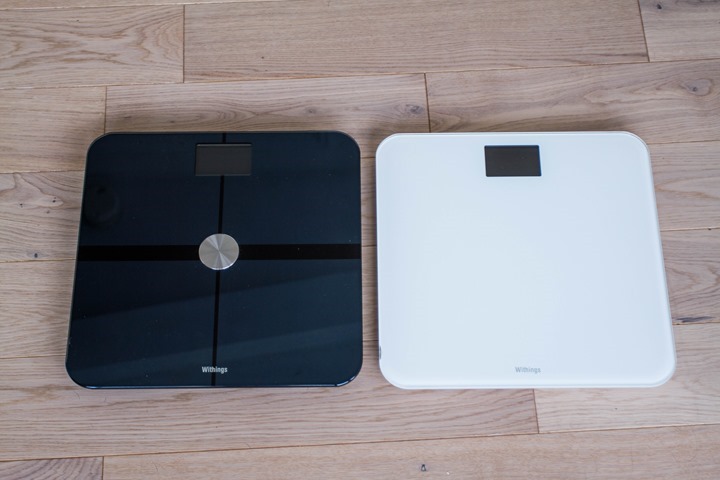
Best Options: Fitbit Aria or Withings WS-30/WS-50*
I’ve been including little snippets of these scales in my Fitbit Surge and Withings Activité reviews. Overall, either scale is a solid option and really just depends on if you’re aligned to either of those platforms already (Fitbit or Withings). If not, poke at the slight differences with 3rd party partners, and see if either of those partnerships matters. Failing that…flip a coin.
Seriously – they’re near identical scales (exempting the more advanced WS-50 with pulse and air monitoring, and body fat). Any other relevant differences are partnerships or platforms. And, again, they’re both great scales. I use them both, frankly just depending on which bathroom I’m in.
*The one exception here is the new Garmin Index scale, if you’re heavily aligned to Garmin. I have a fully separate post coming out on Thursday talking in detail about choosing a WiFi weight scale (yes, perfectly timed to your Thanksgiving self-stuffing). But basically, if you’re really into having all your Garmin data in one spot, then the Index makes a ton of sense (and thus far, it works pretty darn well for me). But if you’ve got data in other spots/partners – then it makes less sense to get the Index since they partner with only a single site: MyFitnessPal.
Copyright DC Rainmaker – Updated May 26th, 2016 @ 7:55 pm
Garmin Index Smart WiFi Scale$149LinkLinkLink
Withings WS-50/Smart Body Analyzer WiFi Weight Scale$149LinkLinkLink
Withings WS-30 WiFi Weight Scale$99LinkLinkLink
FitBit Aria WiFi Weight Scale$129LinkLinkLink
Action Cameras:
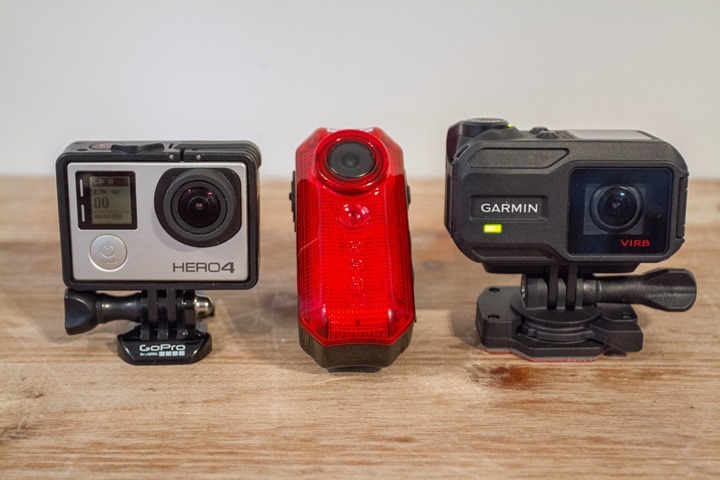
Best All Around Action Cam: GoPro Hero4 Silver
I love my little Hero4 Silver. Seriously, you’re not taking it from me. It’s not just one thing that makes it awesome. It’s the quality of the lens/resolution I get on both photo and video, it’s the super-crisp touch screen on the back, it’s the fact that the app is super-mature and easy to use (and far faster than Garmin’s), plus the size makes it easy to use. I bring this everywhere; it’s always with me on every trip and the vast majority of runs and rides. Plus, when I want to shoot 2.7K, I can do that.
I have virtually no complaints about the camera, except I wish that it also did what Garmin’s VIRB XE does with dashboard metrics.
Best Cam for Sports Metrics: Garmin VIRB XE
So why the VIRB XE if I love the Hero4 Silver? Well, there are cases where I want to share videos with various dashboard metrics overlaid on it – like power, speed, pace, etc… For this, the Garmin VIRB XE rocks. They’ve taken all of the quirks of the original VIRB and really cleaned them up, and the desktop software is just super easy to use and produces really pretty videos. I do find the phone app often flaky and slow though.
So why not just use the GoPro combined with a Garmin wearable to record the data and mix after the fact? Well, it’s just one more thing to deal with. For me, I find the time savings worth it. So if I’m shooting something that I want to share that type of info (i.e. a ride or something else that would have data overlaid), I’m going to go for the VIRB XE. I do find that the photo performance in low-light far lags behind the Hero4 Silver, but in good sunny conditions it does quite well.
Best Safety Cam: Cycliq Fly6
Next we’ve got the Fly6. If you’re not familiar, this isn’t an action cam per se, but it’s the closest category I’ve got. It combines a rear light (which you’d want anyway) with a camera. Basically, this is a safety cam. And not in the sense that it’s going to save your ass, but rather, it’s like an insurance policy for later. I have it on my bikes while riding around the vast majority of the time and it’s just silly easy to use.
Now, this isn’t really a replacement for a GoPro or the like, it’s not got that level of quality. Rather – it’s just so in the event something bad happens to you – you can prove it wasn’t your fault, or even better – catch the person if they left you at the scene.
Action Cam Mounts: K-Edge Action Cam Mounts
Now, while I often use the Barfly for my Garmin Edge, I really prefer the K-Edge mounts for my action cams. I’ve come to love the sturdiness of the K-Edge mounts, especially the new combo mounts they’ve made (Garmin + GoPro). It’s hard to explain to someone how incredibly rock-solid these mounts are until you attach a camera to them and don’t even get a sliver of a millimeter of sway on them (unlike a stock mount). Incredible. I’ve bought front/back mounts for every bike I have, love them.
Copyright DC Rainmaker – Updated May 26th, 2016 @ 7:55 pm
Cycliq Fly6 Bike Camera/Light$169LinkLinkLink
Garmin VIRB XE$399LinkLinkLink
GoPro Hero4 Silver$399LinkLinkLink
K-Edge Action Cam MountsVariesLinkLinkLink
Activity Trackers:
So…here’s the thing, in the past, I used to have a section here on activity trackers. But the market has simply gotten so big, and the features in general overlap each other on so many units. It’s nearly impossible to simply say “Go get a Fitbit” or “Go get a Polar Loop” or “Go Get a Jawbone”.
Instead, it’s really best to look at whatever activity trackers either:
A) Your friends are using
B) Your existing device is on
Seriously. If you’re motivated by competing with friends, then you want to be on the same platform as them. So if they’re all on Fitbit – go get a Fitbit. And same goes for Garmin or Withings, or anyone else.
Secondly, if you already have (for example) a Garmin device, heck, it’s likely it has an activity tracker in it. But say you want something else – in that case, get something on the same platform as that – so you can track everything in one place. It’d make no sense to have a Fitbit activity tracker and a Garmin GPS watch.
Next to last – the vast majority of activity trackers are roughly accurate. To that I meant that no activity tracker on the market is perfect. None. Instead, they are estimations – treat them as such. Each company tries to fine tune their algorithms for various use cases. Some might be better at guarding against false positives in the shower, but less so doing dishes. Others the inverse. What matters is that at the end of the day if you’re activity tracker said you only did 2,000 steps, and you’re goal was 10,000 steps – then you were…lazy. Meanwhile, if it says you did 9,782 steps and you think you really did 9,923 or 9,458 – just go walk around the block an extra time. It’s about tracking trends – not exacts.
Lastly, in general I prefer activity trackers that have a display on them. If I didn’t need a display, then most phones these days can track 99% of your awake time anyway. So for me, I want to be able to glance at my wrist and see how many steps I have and how far from a goal I am.
Cycling Power Meters:
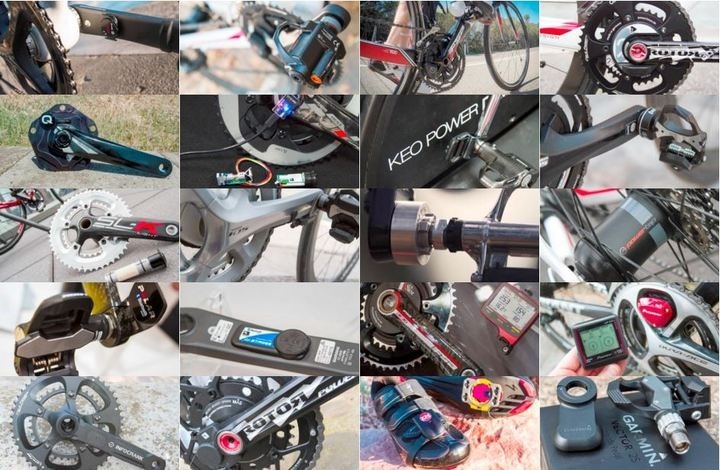
Choosing a power meter is a tough decision matrix. Anyone who answers the question “Which power meter should I choose?” and instantly names a specific brand name/model upfront, is full of crap. The correct answer is “Tell me more about your usage plans?”
There are so many variables that go into that decision beyond just price. For example: How many bikes? What type of bike? What type of pedals? Do you want to move it around a lot? Race wheels or not? What do you want to measure? And on and on.
The good news is that I cover these in-depth in my Power Meter Buyer’s Guide from this fall. Nothing has changed there since then (neither in products nor in my opinions), and I don’t expect any shifts in the near future.
Cycling Trainers:
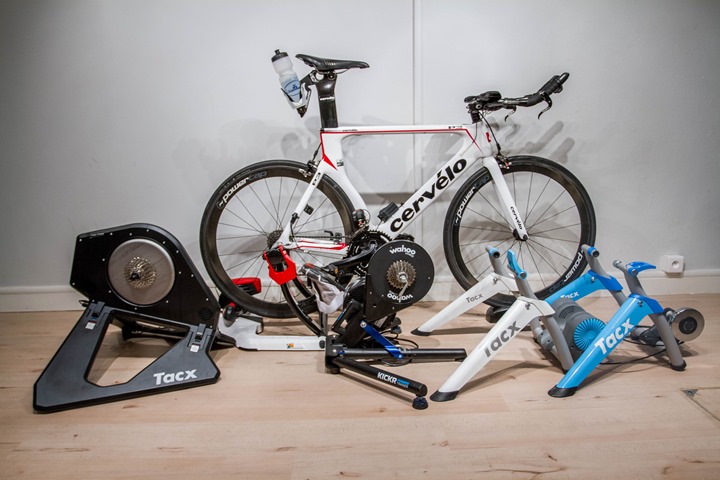
The best way to cover this section is to go read my complete 2015 cycling trainers guide, so again like power meters, I’d go over and check out that post for all my recommendations (a massive list on a slew of categories).
Obviously, given it’s now basically the trainer season, there’s no more trainers coming out till at the earliest mid-next year, with most announcements typically happening at Eurobike in August each year.
Don’t forget the Comparison Tool!
Ok, lots of recommendations. If there’s a category I’ve missed (entirely plausible) – just drop a note in the comments and I’ll try and come up with a recommendation and add it above.
More importantly though, you can mix and match just about everything I’ve talked about above, with in-depth comparison tables over at the product comparison calculator, which today supports: Action Cameras, Heart Rate Straps, Watches/Bike Computers, Power Meters, Activity Monitors, and Trainers.
Select product use/budget for a comparison from the drop down menus:
Select product use:
Swim
Bike
Run
Tri
Hike
Select price range:
Budget
Moderate
Highend
Note: While many running watches have a basic bike mode, only running units that are multi-sport focused are also included in the bike-only results (in addition to bike-specific units). Hiking units are those that include a Barometric Altimeter, Magnetic Compass and navigational functions.
Or select products for comparison by clicking the product boxes below:
Adidas Smart Run GPS
Apple Watch Series 2 & Nike+ Edition
Bia GPS
Bryton Cardio 60 Multisport Watch
CycleOps Joule 2.0 (Original)
CycleOps Joule GPS
Epson SF-810
FINIS Swimsense
Fitbit Surge
Garmin Edge 1000
Garmin Edge 20
Garmin Edge 200
Garmin Edge 25
Garmin Edge 500
Garmin Edge 510
Garmin Edge 520
Garmin Edge 705
Garmin Edge 800
Garmin Edge 810
Garmin Edge 820
Garmin Edge Touring (Normal)
Garmin Edge Touring (Plus)
Garmin Epix
Garmin Fenix
Garmin Fenix2/Fenix2 SE
Garmin Fenix3
Garmin Fenix3 HR
Garmin Fenix5 (5/5S/5X)
Garmin Forerunner 10
Garmin Forerunner 110
Garmin Forerunner 15
Garmin Forerunner 210
Garmin Forerunner 220
Garmin Forerunner 225
Garmin Forerunner 230
Garmin Forerunner 235
Garmin Forerunner 25
Garmin Forerunner 305
Garmin Forerunner 310XT
Garmin Forerunner 35
Garmin Forerunner 405
Garmin Forerunner 410
Garmin Forerunner 60/70
Garmin Forerunner 610
Garmin Forerunner 620
Garmin Forerunner 630
Garmin Forerunner 735XT
Garmin Forerunner 910XT
Garmin Forerunner 920XT
Garmin Forerunner 935
Garmin Swim
Garmin Tactix
Garmin Vivoactive
Garmin Vivoactive HR
Garmin Vivosmart HR+
Leikr GPS
Magellan Echo
Magellan Switch & Switch Up
Microsoft Band 2
Mio Alpha Optical HR Monitor
Motorola Motoactv
Nike+ GPS Sportwatch
O-Synce Navi2Coach
Polar A300
Polar M200
Polar M400
Polar M450
Polar M600
Polar RC3
Polar RCX3
Polar RCX5
Polar V650
Polar V800
Soleus 1.0 GPS
Soleus 2.0 GPS
Suunto Ambit
Suunto Ambit2
Suunto Ambit2 R
Suunto Ambit2 S
Suunto Ambit3 Peak
Suunto Ambit3 Sport
Suunto Spartan Sport Wrist HR
Suunto Spartan Ultra
Timex Cycle Trainer 2.0 GPS
Timex Global Trainer
Timex Marathon GPS
Timex One GPS+
Timex Run Trainer GPS 1.0
Timex Run Trainer GPS 2.0
Timex Run x20 GPS
Timex Run x50
TomTom Multisport
TomTom Multisport Cardio
TomTom Runner
TomTom Runner Cardio
TomTom Spark
TomTom Spark 3/Runner 3
Wahoo ELEMNT
Wahoo ELEMNT BOLT
As always, thanks for reading – and supporting the site!
Copyright DC Rainmaker – Updated May 26th, 2016 @ 7:55 pm
Garmin Fenix3$499LinkLinkLink










